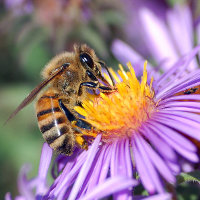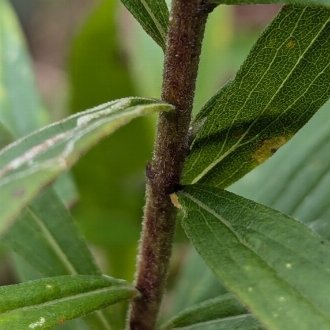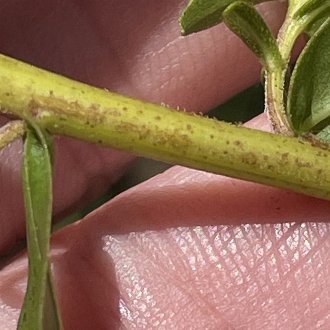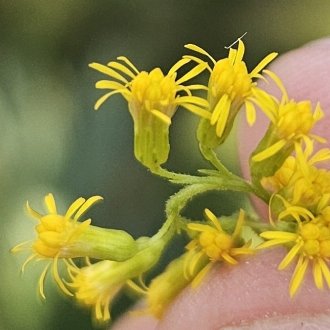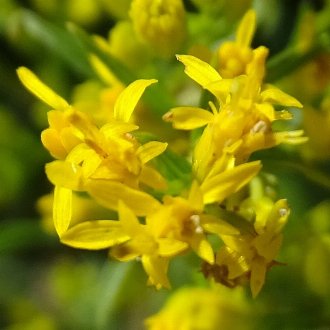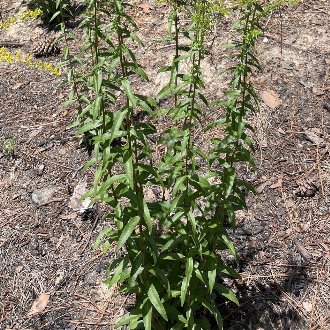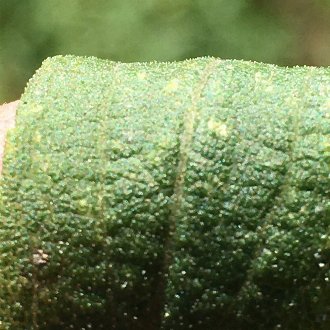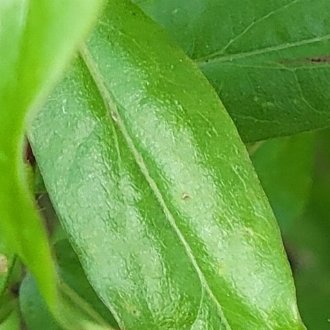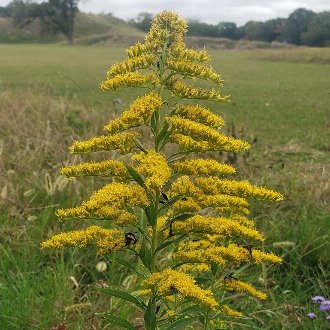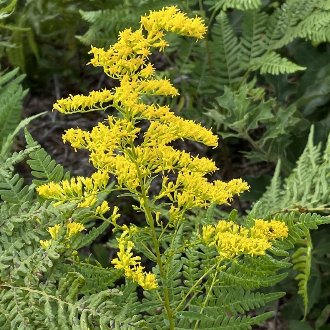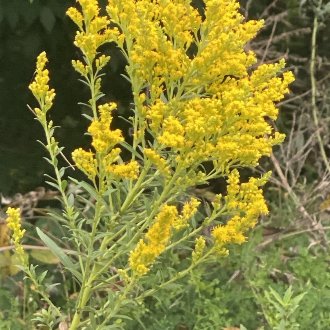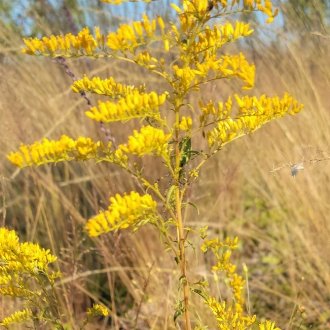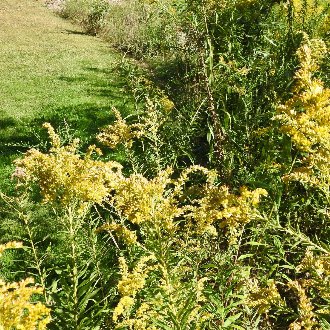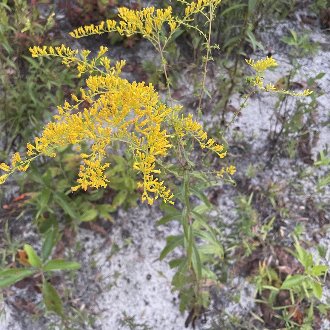Tall Goldenrod vs Sweet Goldenrod
These two goldenrods are sometimes confused; both tend to grow in dry habitats. They are usually easy to tell apart by close examination of the leaves, and they have numerous other differences. S. altissima ranges farther north and much farther west, and prefers richer, finer-textured soils, ranges onto higher-pH soils, and tolerates much greater levels of disturbance. S. odora is more restricted to the southeast and is strictly limited to acidic, nutrient-poor soils, and is more shade-tolerant, but less tolerant of disturbance.
Tall Goldenrod (Solidago altissima) | Sweet Goldenrod (Solidago odora) |
A common, aggressive perennial of rich, sunny, disturbed sites, native to a wide range across North America. | A clumping perennial of nutrient-poor, acidic soils, with distinctive anise-scented leaves. |
Leaves lower down on the stem have a triple-veined look, with two prominent side-veins running most of the length of the leaf, parallel to the central vein. Photo © Sandy Wolkenberg, CC BY 4.0. | Leaves lack a triple-veined look. Usually only the central vein is prominent and the rest of the leaf is indistinct. Photo © Carrie Seltzer, CC BY 4.0. |
Stem is densely covered in short hairs, even lower down on the plant. Photo © Skyler Principe, CC BY 4.0. | Stem is much less hairy on average. Lower portions of the stem may be nearly hairless, except for a small amount of hair in lines near each leaf. Stems sometimes become slightly more hairy in the inflorescence. Photo © Becky Dill, Public Domain. |
Flowerheads have more ray florets: usually 8–13, rarely 5–17. Photo © Daniel McClosky, CC BY 4.0. | Flowerheads have fewer ray florets: usually 3-4, rarely 5-6. Photo © Sandra Keller, CC BY 4.0. |
Plants are rhizomatous, forming large colonies of up to 40 stems, occasionally more. Photo © botany08, CC BY 4.0. | Plants are not rhizomatous, instead growing in clumps with up to 5 stems, occasionally more, originating from a central point. Photo © Becky Dill, Public Domain. |
Upper leaf surfaces are rough to the touch and not shiny. Photo © Becky Dill, Public Domain. | Upper leaf surfaces are smooth and often shiny. Photo © Matt Pelikan, CC BY 4.0. |
Inflorescences average larger (usually 100–1200 flowerheads) and denser, and usually have a more regular pyramidal shape, with adjacent branches usually similar in length. Photo © Jody Shugart, CC BY 4.0. | Inflorescences average smaller (usually 75–350 flowerheads) and more open, and are more irregular, with some branches shorter or longer than other directly adjacent branches. Photo © John P, CC BY 4.0. |
Some plants have an inflorescence with ascending branches where the flowering parts of these branches are still ascending. Photo © Sandy Wolkenberg, CC BY 4.0. | Although plants often have ascending branches in the inflorescence, especially lower down, these branches usually flatten out closer to their tips such that the flowering parts of the branches are mostly horizontal. Photo © Jay Horn, CC BY 4.0. |
Found in a wider range of habitats, and ranges into habitats with richer, finer-textured soil, where there is more competing vegetation. Frequent in disturbed anthropogenic habitats. Slightly more restricted to sunny habitats. Photo © sudomir, CC BY 4.0. | Strictly limited to sites with nutrient-poor, acidic soil, where there is little competition from other plants. Prefers coarse-textured soils such as sand. Mostly restricted to undisturbed natural areas. Tolerates slightly more overhead shade. Photo © inbetweenbays, CC BY 4.0. |
Additional Notes
Although these two species are usually easy to tell apart by only looking at one or two characteristics, we recommend closely examining all of these characteristics because greater familiarity with each species will help to distinguish each species from others.The taller height of S. altissima reflects its preference for richer soils, where there tends to be steeper competition from other plants. Its rhizomatous habit is made possible by the abundance of both sunlight and nutrients, and it helps the plant to adapt to the changing conditions and often heavy disturbance in the habitats where it grows.
The habitats where S. odora grows tend to be more nutrient-poor but also more stable, so the plant has access to fewer resources with which to expand and spread vegetatively, but it also has less need to move around.
References & External Resources
These short lists show only links helpful for ID. For a complete list of references and resources also covering other aspects of ecology, visit the links section of the full article on each plant, which is the first entry here.

